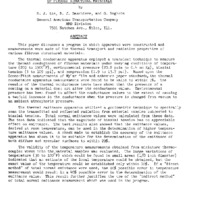-
Title
-
Thermal Transport and Radiative Properties of Fibrous Structural Materials
-
Description
-
This paper discusses a program in which apparatus were constructed and measurements were made of the thermal transport and radiative properties of various fibrous structural materials.
The thermal conductance apparatus employed a transient technique to measure the thermal conductance of fibrous materials under varying conditions of temperature (200 to 1500°F), environmental pressure (20.2 psia to 0.4 mm Hg), biaxial tension (1 to 109 ppi), and compression (1.9 to 13.7 psi). Based upon the Cenco-Fitch measurements of Mylar film and asbestos paper standards, the thermal conductance apparatus measurements were found to be valid to within 7%. The results of the thermal conductance tests have shown that the presence of a coating on a material does not alter its conductance value. Environmental pressure has been found to affect the conductance values to the extent of causing a twofold increase in the conductance when the pressure is changed from vacuum to an ambient atmospheric pressure.
The thermal emittance apparatus utilized a goniometric technique to spectrally scan the transmitted and reflected radiation from material samples subjected to biaxial tension. Total normal emittance values were calculated from these data. The test data indicated that the magnitude of biaxial tension has no appreciable effect on emittance. The test results also showed that the emittance values, derived at room temperature, can be used in the determination of higher temperature emittance values. A check made to establish the accuracy of the emittance apparatus has shown it to be suitable for the determination of the emittance of both diffuse and specular surfaces to within 29%.
The validity of the temperature measurements obtained from miniature thermocouples woven into the material samples was evaluated. The large variations of temperature (30 to 100°F) which could be found in small areas (1/8 inch diameter) indicated that an estimate of the local temperature could be obtained, but the exact value of the temperature could be established only within 10%. If a "direct method" of total normal emittance were used, the 10% possible error in temperature measurement would result in a 40% possible error in the determination of the emittance value. This result further justifies the use of the "indirect method" of total normal emittance measurement which was used in the program.
-
Date
-
1963
-
Date Issued
-
1963-01
-
Publisher
-
Wright-Patterson Air Force Base, OH : Directorate of Materials & Processes, Aeronautical Systems Division, Air Force Systems Command
-
DoD Project
-
7320 - Fibrous Materials for Decelerators and Structures
-
DoD Task
-
None Given
-
Abstract
-
This paper discusses a program in which apparatus were constructed and measurements were made of the thermal transport and radiative properties of various fibrous structural materials.
The thermal conductance apparatus employed a transient technique to measure the thermal conductance of fibrous materials under varying conditions of temperature (200 to 1500°F), environmental pressure (20.2 psia to 0.4 mm Hg), biaxial tension (1 to 109 ppi), and compression (1.9 to 13.7 psi). Based upon the Cenco-Fitch measurements of Mylar film and asbestos paper standards, the thermal conductance apparatus measurements were found to be valid to within 7%. The results of the thermal conductance tests have shown that the presence of a coating on a material does not alter its conductance value. Environmental pressure has been found to affect the conductance values to the extent of causing a twofold increase in the conductance when the pressure is changed from vacuum to an ambient atmospheric pressure.
The thermal emittance apparatus utilized a goniometric technique to spectrally scan the transmitted and reflected radiation from material samples subjected to biaxial tension. Total normal emittance values were calculated from these data. The test data indicated that the magnitude of biaxial tension has no appreciable effect on emittance. The test results also showed that the emittance values, derived at room temperature, can be used in the determination of higher temperature emittance values. A check made to establish the accuracy of the emittance apparatus has shown it to be suitable for the determination of the emittance of both diffuse and specular surfaces to within 29%.
The validity of the temperature measurements obtained from miniature thermocouples woven into the material samples was evaluated. The large variations of temperature (30 to 100°F) which could be found in small areas (1/8 inch diameter) indicated that an estimate of the local temperature could be obtained, but the exact value of the temperature could be established only within 10%. If a "direct method" of total normal emittance were used, the 10% possible error in temperature measurement would result in a 40% possible error in the determination of the emittance value. This result further justifies the use of the "indirect method" of total normal emittance measurement which was used in the program.
-
Index Abstract
-
Contrails only
-
Laboratory
-
Directorate of Materials & Processes
-
Distribution Conflict
-
No
-
Distribution Classification
-
1
-
Identifier
-
AD0299030
-
DTIC Record Exists
-
No
-
Report Availability
-
Full text available
-
Creator
-
Lis, S. J.
-
Engholm, G.
-
Baschiere, R. J.
-
Extent
-
56
-
Corporate Author
-
General American Transportation Company, MRD Division
-
Report Number
-
ASD TDR 62-964, p. 235-289
-
Provenance
-
Lockheed Martin Missiles & Fire Control
-
Type
-
article
-
Relation
-
This paper was presented at the Directorate of Materials and Processes "Symposium on Fibrous Materials" held in Dayton, Ohio, on 16-17 October 1962
-
Format
-
1 online resource (56 pages)
 ASDTRD62-964paper12.pdf
ASDTRD62-964paper12.pdf